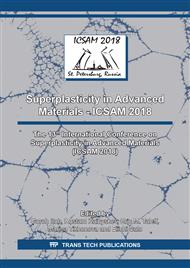p.78
p.84
p.91
p.97
p.103
p.109
p.114
p.120
p.126
Study on the Enhanced Superplasticity of Mg-Li Based Alloy by a Stepped Deformation Method
Abstract:
A two-step deformation approach is proposed for the superplastic deformation (SPD) of Mg-9Li-1Al (LA91) alloy. This method has been successfully applied to titanium alloys and has induced enhanced superplasticity, and the feasibility of the method for the Mg-Li based alloy is explored. In a previous research, single-step SPD of LA91 alloy has been investigated, and the highest elongation of 563.7% was obtained by using the 8-pass equal channel angular extruded material, by the maximum strain rate sensitivity (Maxm) mode deformation. While in this research, the raw material in the as-extruded state is utilized. Constant velocity (Constv) and constant strain rate (CSR) modes are adopted for the first step of the deformation, respectively, with the elongation of the first step from 50% to 150%. The Maxm mode, in which the strain rate sensitivity m is always kept to be the maximum value, is applied to the second step. In addition, single-step tests by Constv, CSR and Maxm modes until fracture are conducted. The experimental temperature is 300°C, which was proved to be the optimum temperature for the SPD of this material in the previous research. The result shows that the 2-step method can greatly improve the superplasticity of the LA91 alloy, especially for the CSR mode deformation, and the maximum elongation obtained is 535.3%, by the CSR-Maxm mode, which is comparable to the optimum result in the previous research.
Info:
Periodical:
Pages:
103-108
Citation:
Online since:
July 2018
Authors:
Price:
Сopyright:
© 2018 Trans Tech Publications Ltd. All Rights Reserved
Share:
Citation:


